Meet Meaningful Use Measures with PCC
How can you use PCC EHR to meet the Meaningful Use measures required for your EHR incentive attestation? How should you chart and configure your system, in order to record medical information so that your numbers are accurate?
PCC EHR includes a Meaningful Use Measures report that calculates how well your eligible professionals meet each statistical Meaningful Use measure. You can adjust your office’s workflow and use PCC EHR differently in order to satisfy the requirements for your clinicians. Read below for configuration and usage tips.
Contents
- 1 PCC’s Current Certification Statuses for MU and PCMH
- 2 Things to Consider Before You Begin
- 3 What Measures Am I Required to Meet and Report On?
- 4 Adjust Your Workflow to Meet MU Objectives
- 4.1 Objective 1: (Y/N) Protect Patient Health Information
- 4.2 Objective 2: (Y/N) Clinical Decision Support
- 4.3 Objective 3: Computerized Provider Order Entry (CPOE)
- 4.4 Objective 4: Electronic Prescribing
- 4.5 Objective 5: Health Information Exchange
- 4.6 Objective 6: Patient Specific Education
- 4.7 Objective 7: Medication Reconciliation
- 4.8 Objective 8: Patient Electronic Access
- 4.9 Objective 9: Secure Electronic Messaging
- 4.10 Objective 10: (Y/N) Public Health Reporting
- 4.11 Provider Configuration for Meaningful Use Calculations
PCC’s Current Certification Statuses for MU and PCMH
PCC EHR is 2015E Cures Update-certified and is listed on the Certified Health Product List (CHPL) maintained by the Office of the National Coordinator for Health Information Technology (ONC). Please contact PCC Support if you’d like an update or for help understanding and attesting for the EHR Medicaid Incentive program or PCMH programs in your state. A member of our team can show you what you need to apply and help you evaluate your options.
Things to Consider Before You Begin
Here are some other topics to consider as you use PCC EHR to chart for and measure Meaningful Use.
Run the Report, Review Your Meaningful Use Scores
The Meaningful Use Measures report, available in the Reports menu, calculates your eligible professionals’ compliance with the Meaningful Use measures.
Before you run the report, make sure that you exclude visit reasons that aren’t actually physician visits (such as vaccine-only visits, nurse-only visits, lab-only visits, etc.).
It’s a good idea to familiarize yourself with these reports, and to check them periodically, to make sure you are seeing the results you expect.
Read the Meaningful Use Measures report help article to learn how to run the report.
Meaningful Use Measures Outside of PCC EHR
You may evaluate some of your Meaningful Use measures using other methods, such as your office’s record-keeping or policies outside of PCC EHR. For example, some of the measures are not statistical and merely require attestation, and some require evaluation based on all patients, whether they are in PCC EHR or not.
Eligible Professionals
Your whole office can make workflow and policy changes to help meet Meaningful Use and CQM, but the reporting and evaluation is always done based on eligible professionals who see a certain percentage of Medicaid patients.
Eligible professionals under the Medicaid EHR Incentive Program include:
- Physicians (primarily doctors of medicine and doctors of osteopathy)
- Nurse practitioner
- Certified nurse-midwife
- Dentist
- Physician assistant furnishing services in a Federally Qualified Health Center or Rural Health Clinic that is led by a physician assistant.
To qualify for an incentive payment under the Medicaid EHR Incentive Program, an eligible professional must meet one of the following criteria:
- Have a minimum 30% Medicaid patient volume
- Have a minimum 20% Medicaid patient volume, and is a pediatrician
- Practice predominantly in a Federally Qualified Health Center or Rural Health Center and have a minimum 30% patient volume attributable to needy individuals
Children’s Health Insurance Program (CHIP) patients do not count toward the Medicaid patient volume criteria.
The MU and CQM reports evaluate a specific provider’s visits from a certain time period. Your whole office may institute a policy of providing patient handouts, recording vitals and charting in a certain way. The reports, however, will reflect how well the eligible professional meets those standards for the patients.
End of Visit: Sign Visits and Use the Electronic Encounter Form
You should always have an eligible professional sign their visits, and your office should use the “Bill” button and review the diagnoses and procedures for each visit.
If your office does not use the electronic encounter form, contact PCC Support for help getting started.
Learn More About Meaningful Use
There is more information about Meaningful Use at pcc.com. Visit cms.gov to learn more about Meaningful Use. You can read more about the modified stage 2 program requirements for 2017 on the CMS website.
What Measures Am I Required to Meet and Report On?
Beginning in 2015 and extending through the end of 2018, eligible professionals (EPs) can meet Meaningful Use requirements by following the Modified Stage 2 Objectives and Measures.
In addition, eligible providers must report on nine Clinical Quality Measures, although there are no required thresholds for these measures. Read How to Chart for Each Clinical Quality Measure in PCC EHR for more information.
Overview of Modified Stage 2 Objectives and Measures
For a quick understanding of each objective, use the table below. You can click the “More Details” links to jump directly to a longer description, accompanied by screenshots.
| MU Objective | Objective Description | Attestation Requirements | Configuration in PCC | Clinician Workflow |
|---|---|---|---|---|
| Objective 1: Protect Patient Health Information |
Protect electronic health information created or maintained by the certified EHR through the implementation of appropriate technical capabilities | Y/N (must answer “Yes”) |
N/A | Conduct or review a security risk analysis of certified EHR technology, and implement updates as necessary |
| Objective 2: Clinical Decision Support |
Measure 1: Implement 5 clinical decision support interventions related to related to 4 or more clinical quality measures (CQMs)Measure 2: Enable drug-drug and drug-allergy interaction checks | Y/N (must answer “Yes” to both measures) |
Measure 1: Create clinical alerts related to four or more CQMsMeasure 2: Set up PCC eRx user access for each EP | Measure 1: Acknowledge clinical alerts as they appear while charting for affected patientsMeasure 2: PCC eRx automatically checks all medication orders for drug or allergy interactions |
| Objective 3: Computerized Provider Order Entry (CPOE) |
Use computerized provider order entry (CPOE) for medication, laboratory, and radiology orders directly entered by eligible providers | Measure 1: >60% of medication ordersMeasure 2: >30% of laboratory orders
Measure 3: >30% of radiology orders |
Measure 1: Set up PCC eRx user access for each EP; work with PCC Support to ensure that each provider is correctly linked to a PCC EHR user. Measure 2: Set up lab orders in PCC EHR, and add them to chart note protocols
Measure 3: Set up radiology orders in PCC EHR, and add them to chart note protocols |
Measure 1: Use PCC eRx to generate and send prescriptions electronicallyMeasure 2: Use the Lab component to order labs when charting in PCC EHR
Measure 3: Use the Radiology component to order radiology tests when charting in PCC EHR |
| Objective 4: Electronic Prescribing |
Generate, query for a drug formulary, and transmit permissible prescriptions electronically | >50% of prescriptions written |
|
|
| Objective 5: Health Information Exchange |
Generate a summary of care record through the EHR and electronically submit to the receiving provider for patients who are referred or transferred to another setting of care | >10% of referral orders and transitions of care |
|
|
| Objective 6: Patient Specific Education |
Use certified EHR technology to identify clinically relevant patient-specific education resources and provide them to patients | >10% of patients seen during the reporting period | N/A |
|
| Objective 7: Medication Reconciliation |
Perform a medication reconciliation whenever a patient is transitioned into the eligible provider’s care from another setting of care | >50% of incoming transitions of care |
|
During visits:
When receiving incoming DSM:
|
| Objective 8: Patient Electronic Access |
Measure 1: Provide patients (or authorized representatives) the ability to view online, download, and transmit their health information within 4 business days
Measure 2: Patients or their authorized representative view, download, or transmit to a 3rd party their health information |
Measure 1: >50% of patients seen during the reporting period
Measure 2: >5% of patients seen during the reporting period |
Measure 1: Contact PCC support to enable the patient portal, My Kid’s Chart, for your practiceMeasure 2: Use the Patient Portal Manager tool to customize what data your practice will share with patients | Measure 1: Use the Patient Portal Manager tool to create portal accounts for patients or their authorized representative within 4 business days of the visitMeasure 2: Encourage patients and their families to use My Kid’s Chart |
| Objective 9: Secure Electronic Messaging |
Use secure electronic messaging to communicate with patients about relevant health information | >5% of patients seen during the reporting period |
|
|
| Objective 10: Public Health Reporting | Actively engage with a public health agency to submit electronic public health data from a certified EHR except where prohibited and in accordance with applicable law and practice | Y/N (must answer “Yes” to 2 of 3) Measure 1: Immunization RegistryMeasure 2: Syndromic SurveillanceMeasure 3: Specialized Registry |
Contact PCC support to discuss any needed configuration changes | Measure 1: Contact PCC support to determine if you are submitting to your state or if a connection can be establishedMeasure 2: Check with your state/AAP to see if your jurisdiction has a public health agency that is capable of receiving electronic syndromic surveillance data
Measure 3: Check with your state/AAP to determine if a specialized registry exists. Document your efforts |
You can download specification sheets for each measure from the EHR Incentive Program Modified Stage 2 Objectives and Measures chart, provided by CMS.
Adjust Your Workflow to Meet MU Objectives
What actions do you need to take to meet each of the Meaningful Use measures, and which measures require tracking statistical data through PCC EHR?
Objective 1: (Y/N) Protect Patient Health Information
This objective requires the protection of electronic health information created or maintained by the certified EHR through the implementation of appropriate technical capabilities.
This is a Yes/No objective.
You must be able to answer “Yes” in order to meet this objective.
Your practice needs to conduct or review a security risk analysis of certified EHR technology, and implement updates as necessary. The risk analysis or review needs to be completed prior to the end of the reporting period. If you are reviewing an existing risk analysis, be sure to document and date that review. States can (and will) audit your analysis and/or review.
Security Risk Analysis online resources:
- HIPAA and Security Risk Assessments for the Pediatric Practice on learn.pcc.com.
- Security Risk Analysis Tip Sheet from cms.gov.
- Security Risk Assessment Tool from HealthIT.gov.
Objective 2: (Y/N) Clinical Decision Support
This objective requires the use of clinical decision support to improve performance on high-priority health conditions.
This is a Yes/No objective, with two separate measures.
You must be able to answer “Yes” to each of the measures in order to meet this objective.
Measure 1: Implement Clinical Decisions
You need to attest that you have implemented five (5) clinical decision support interventions, related to four or more clinical quality measures at a relevant point in patient care for the entire reporting period.
PCC recommends using PCC EHR clinical alerts to meet this measure.
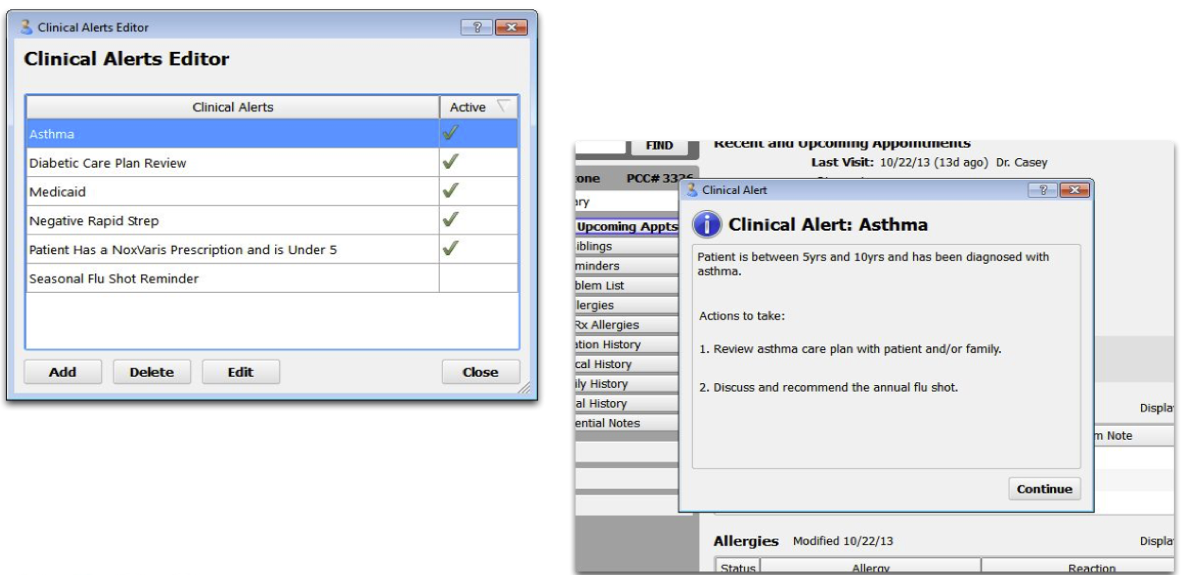
If your practice prefers not to use clinical alerts, CMS has identified the following alternative examples of “clinical decision support”:
- Clinical guidelines (consider developmental or depression screening templates built into PCC EHR)
- Condition-specific order sets
- Documentation templates
- Diagnostic support
- Contextually relevant reference information
Measure 2: Enable Drug-Drug and Drug Allergy Interaction Checks
This is a built-in default feature of PCC EHR, so you can attest “Yes”.
Objective 3: Computerized Provider Order Entry (CPOE)
This objective requires the use of computerized provider order entry (CPOE) for medication, laboratory, and radiology orders directly entered by eligible providers.
This objective has three separate measures.
You must meet the required threshold for each of the measures in order to meet this objective.
Measure 1: Use CPOE for >60% of Medication Orders
In order to meet this measure, you must use CPOE to create more than 60% of prescriptions for patients who visit your practice.
- Denominator: Number of medication orders created by the EP during the EHR reporting period
- Numerator: Number of medication orders in the denominator recorded using CPOE
- Exclusion: If you wrote fewer than 100 prescriptions during the reporting period, you can take an exclusion for this measure
Each eligible provider (EP) needs to have PCC eRx enabled on their user account in PCC EHR. In addition, each EP needs to be correctly linked to a PCC EHR user and an underlying system provider. Contact PCC Support for assistance. If this isn’t done, all measures for this objectives will show 0%.
Using PCC EHR’s electronic prescriptions screen (PCC eRx) to create new prescriptions will meet this measure.
For help prescribing with PCC eRx, read the Prescribe Medications article on learn.pcc.com.
Measure 2: Use CPOE for >30% of Lab Orders
In order to meet this measure, you must use CPOE to order more than 30% of your lab orders.
- Denominator: Number of lab orders created by the EP during the EHR reporting period
- Numerator: Number of lab orders in the denominator recorded using CPOE
- Exclusion: If you wrote fewer than 100 lab orders during the reporting period, you can take an exclusion for this measure
If you use PCC EHR to create lab orders, then you are doing what is needed to meet this measure.
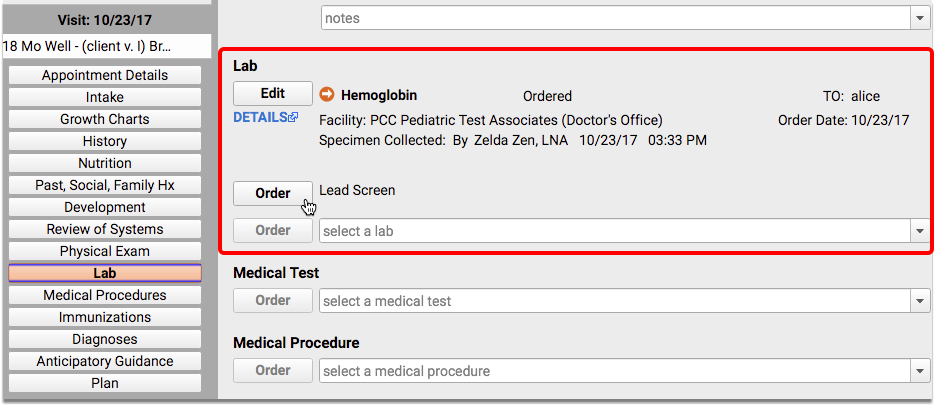
For help setting up lab orders in PCC EHR, read the Lab Configuration article on learn.pcc.com.
For help ordering labs in PCC EHR, read the Order a Lab, Procedure, Supply, or Other Order article on learn.pcc.com.
Measure 3: Use CPOE for >30% of Radiology Orders
In order to meet this measure, you must use CPOE to order more than 30% of your radiology orders.
- Denominator: Number of radiology orders created by the EP during the EHR reporting period
- Numerator: Number of radiology orders in the denominator recorded using CPOE
- Exclusion: If you wrote fewer than 100 radiology orders during the reporting period, you can take an exclusion for this measure
If you use PCC EHR to create radiology orders, then you are doing what is needed to meet this measure.
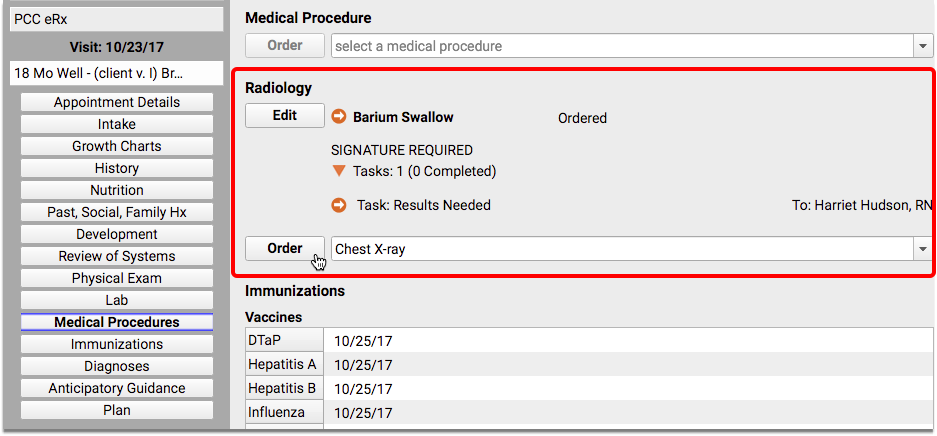
For help setting up radiology orders in PCC EHR, read the “Configure Radiology Orders with Discrete Results” section of the Order Configuration Examples article on learn.pcc.com.
For help with radiology orders in PCC EHR, read the Order a Lab, Procedure, Supply, or Other Order article on learn.pcc.com.
Objective 4: Electronic Prescribing
This objective requires permissible prescriptions to be generated, queried for a drug formulary, and transmitted electronically, using a certified EHR.
In order to meet this measure, more than 50% of prescriptions that you write need to be queried for a drug formulary and transmitted electronically. You may choose to include or not include controlled substances.
- Denominator: Number of prescriptions written for drugs requiring a prescription in order to be dispensed (including or not including controlled substances) during the EHR reporting period
- Numerator: Number of prescriptions in the denominator generated, queried for a drug formulary and transmitted electronically using a certified EHR
- Exclusion: If you wrote fewer than 100 prescriptions during the reporting period, you can take an exclusion for this measure
Your practice must be using PCC eRx in order to generate and transmit prescriptions electronically.
Each eligible provider (EP) needs to have PCC eRx enabled on their user account in PCC EHR. In addition, each EP needs to be correctly linked to a PCC EHR user and an underlying system provider. Contact PCC Support for assistance. If this isn’t done, this measure will show 0%.
PCC EHR’s electronic prescribing system (eRx) automatically queries all prescriptions for a drug formulary.
If you use PCC eRx to record and transmit most of your prescriptions to pharmacies, then you are doing what is needed to meet this measure.

You may choose whether to include controlled substances in your totals, if your state allows it. PCC’s MU report can include or exclude controlled substances.
Prescriptions that are generated through the eRx, but are then printed instead of being sent electronically, will not count toward meeting this measure. They will however be counted toward your total prescriptions for the reporting period.
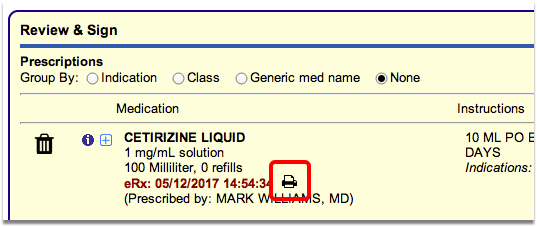
Objective 5: Health Information Exchange
This objective requires summary of care records to be sent electronically for patients who are referred or transitioned to another setting of care.
In order to meet this measure, you must generate a summary of care record through the EHR, and electronically submit it to a receiving provider for more than 10% of referral orders and transitions of care.
- Denominator: Number of referral orders during the reporting period where the EP was the provider for the visit, combined with the number of Summary of Care Records generated where “Related to an outbound transition of care” was selected
- Numerator: Number of referrals and outbound transitions from the denominator where a Summary of Care Record was sent electronically to another clinician or practice via Direct Secure Messaging
- Exclusion: If you initiated less than 100 transfers or referrals (to another setting of care) during the reporting period, you can take an exclusion for this measure
When you refer a patient to a provider outside of your practice, use PCC EHR’s Referral component to create a referral order.
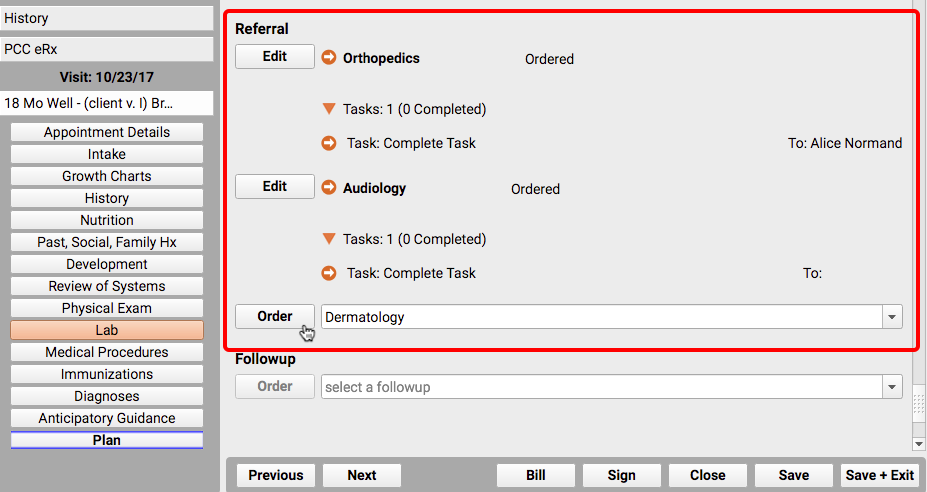
After you have documented the referral – or for patients who you did not refer, but are transferring to an external provider – you will generate a Summary of Care Record report and select either the relevant referral, or “Related to an outbound transition of care” from the drop-down list.
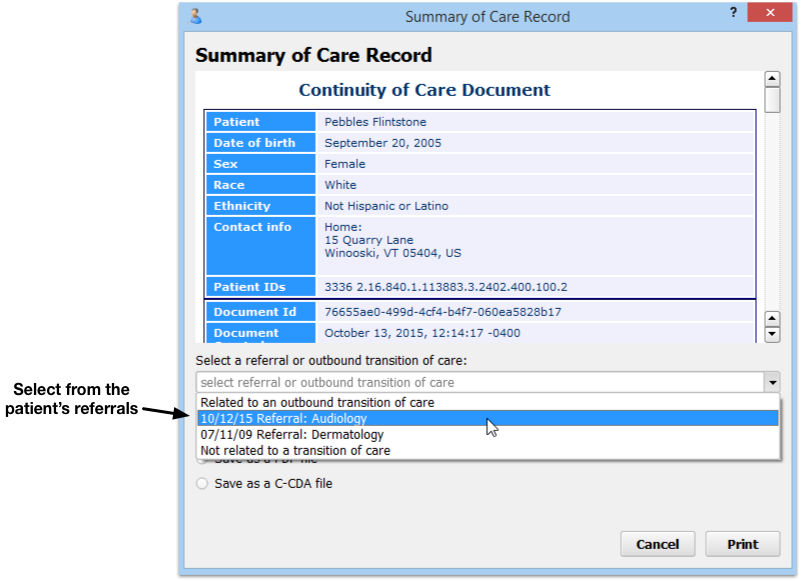
Finally, you need to send the Summary of Care Record to the receiving clinician or practice as a C-CDA file, via Direct Secure Messaging (DSM).
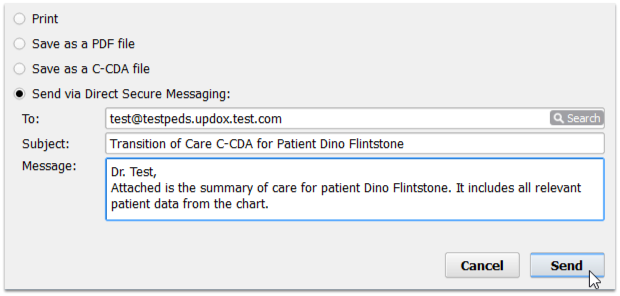
For step-by-step directions on how to generate the report, indicate the referral, and send the file via DSM, read the Summary of Care Record Report article on learn.pcc.com.
If your practice is not currently using DSM, read the Direct Secure Messaging article on learn.pcc.com, and contact PCC Support to get set up.
Objective 6: Patient Specific Education
This objective requires the use of a certified EHR to identify clinically relevant patient-specific education resources, and to provide those resources to patients.
In order to meet this measure, you must use EHR technology to identify and provide an appropriate patient handout or other resource to more than 10% of the patients who visit your office during the reporting period.
- Denominator: Number of unique patients with at least one office visit, seen by the EP during the EHR reporting period
- Numerator: Number of patients in the denominator who were provided patient-specific education resources identified by the certified EHR
While the measure applies to patients with office visits during the reporting period, the education material only needs to have been given during the same calendar year.
To meet this measure, you must access the education source through the Patient Education report, and you need to select one of the patient’s problems, medications, or lab tests from the drop-down field before you select a handout.
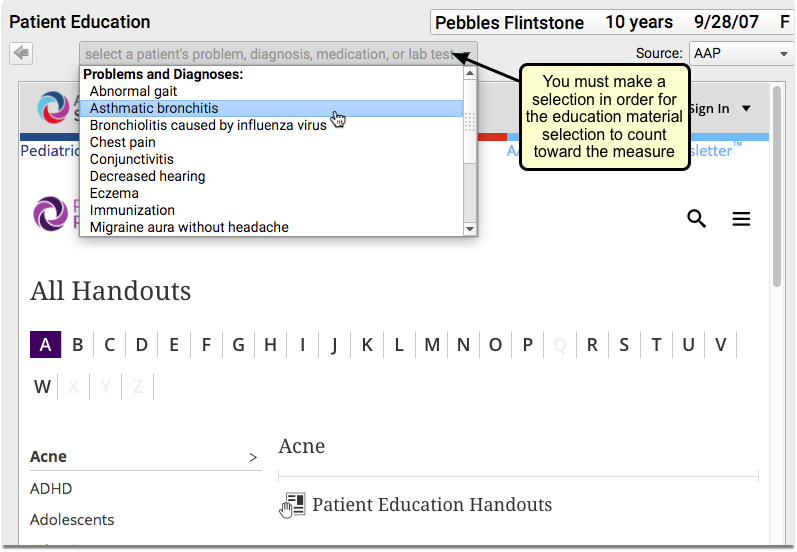
Once you select a handout, you can either print it or save it to the patient portal. Either option will satisfy this objective.
PCC EHR has a built-in library of resource materials for patients. Read Patient Education and Handouts for more information.
Objective 7: Medication Reconciliation
This objective requires a medication reconciliation to be performed whenever a patient is received from another setting of care.
In order to meet this measure, you must perform a medication reconciliation for more than 50% of patients who are transitioned into your care, or for whom you receive an incoming Direct Secure Message with a C-CDA.
- Denominator includes:
- Any visit for the EP where the “Patient transitioned to my care” checkbox is checked in the Transition of Care (ARRA) component
- Direct secure messages received by the EP that include a C-CDA
- Numerator includes:
- Visits from the denominator where the “Medication Reconciliation performed” checkbox is checked in the Transition of Care (ARRA) component
- Direct secure messages from the denominator where the “Reconcile” button has been clicked
Medication Reconciliations During Visits
If you are meeting with a new patent, or if your established patient was seen elsewhere since their last visit with you, review their medications using the Medication History component in PCC eRx. You can add and remove medications to their chart as appropriate.
For help with conducting a review of a patient’s medications, read the Review and Update Medication History article on learn.pcc.com.
In order to track this measure during a visit, make sure that you are using the Transition of Care (ARRA) component within all of your visit protocols, and check the boxes to indicate that a patient has transitioned into your care, and that you performed a medication reconciliation.

Medication Reconciliations With Incoming Direct Secure Messages
Direct Secure Messages that you receive on the Messaging queue are also considered incoming transitions of care.
When you see an incoming C-CDA in a Direct Secure Message, you can click “Reconcile” to review and import medication data (along with problems and allergies).
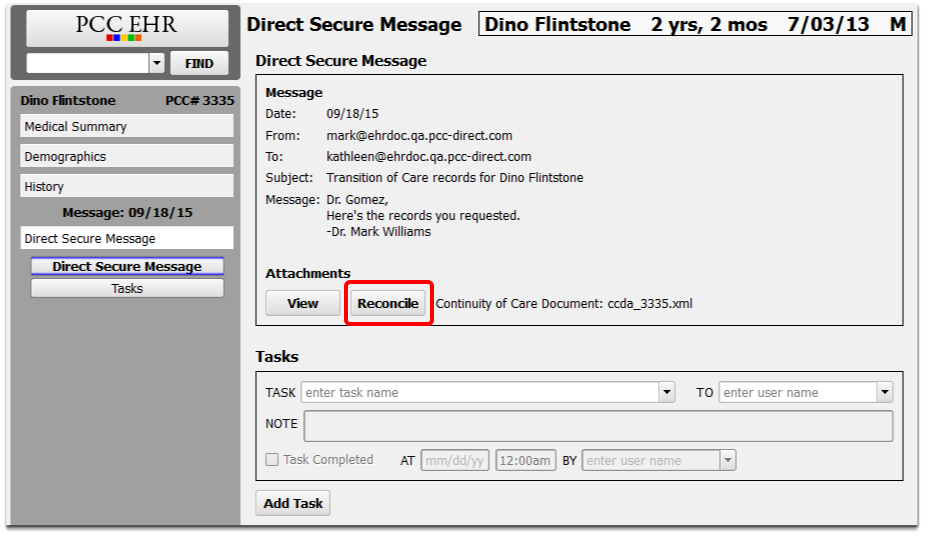
For help with receiving incoming messages, read the “Receive Direct Secure Messages, Including Inbound C-CDA For Transition of Care” section of the Direct Secure Messaging article on learn.pcc.com.
Objective 8: Patient Electronic Access
This objective requires the practice to provide patients the ability to view online, download, and transmit their health information.
This objective has two separate measures.
You must meet the required threshold for each of the measures in order to meet this objective.
Measure 1: Timely Online Access
In order to meet this measure, more than 50% of patients seen during the reporting period need to have a My Kid’s Chart user with access to their records.
- Denominator: Number of unique patients seen by the EP during the EHR reporting period
- Numerator: Number of unique patients (or their authorized representatives) in the denominator who have had a patient portal account created within 4 days of their visit
- Exclusion: If you are located in a county where >50% of patients do not have 3Mbps broadband availability, you can take an exclusion for this measure
PCC EHR includes an optional patient portal, My Kid’s Chart (mykidschart.com).
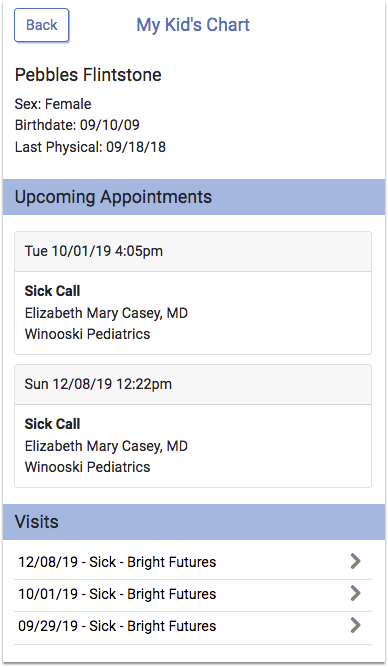
My Kid’s Chart gives patients and families 24-hour access to their medical history, visit summaries, and other helpful information.
Contact PCC to set up My Kid’s Chart. Once the portal has been enabled for your office, you can sign up patients or their authorized representatives using the Patient Portal Manager tool through PCC EHR.
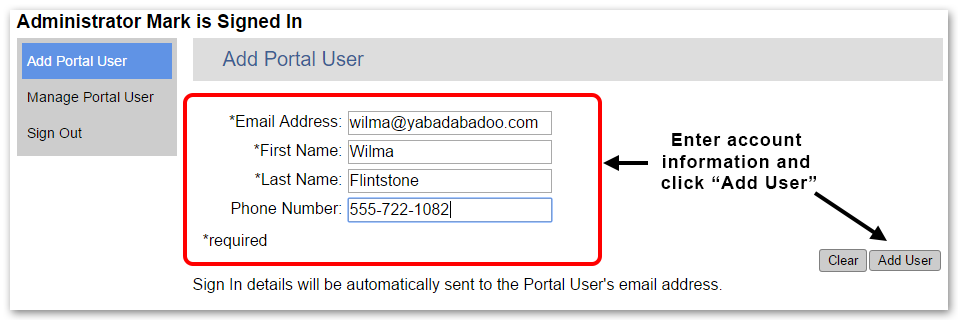
For help creating portal accounts, read the My Kid’s Chart User Account Administration article on learn.pcc.com.
A portal account needs to be created within 4 days of the patient’s visit in order to be counted toward the measure.
If age-based privacy is enabled, patients who meet the emancipation age will still be included in the denominator but will not count in the numerator unless portal access is individually enabled.
To get started with using My Kid’s Chart, read What is My Kid’s Chart, PCC’s Patient Portal.
Measure 2: View, Download, or Transmit Health Information
In order to meet this measure, at least 5% of patients seen in the reporting period need to view, download, or transmit their health information.
- Denominator: Number of unique patients seen by the EP during the EHR reporting period
- Numerator: Number of unique patients (or their authorized representatives) in the denominator who have viewed online, downloaded, or transmitted to a third party the patient’s health information
- Exclusion: If you are located in a county where >50% of patients do not have 3Mbps broadband availability, you can take an exclusion for this measure
When your patients or their authorized representatives log in to My Kid’s Chart, PCC will record their actions. Simply viewing their account will count toward this measure.
To help your patients and families with using My Kid’s Chart, you can print out and share the My Kid’s Chart User’s Guide, found on learn.pcc.com.
Objective 9: Secure Electronic Messaging
This objective requires the use of secure electronic messaging to communicate with patients about relevant health information.
For more than 5% of patients seen by the EP during the EHR reporting period, a secure electronic message must be sent using the patient portal to the patient (or their representative), during the reporting period. The message may be a reply to an incoming message.
- Denominator: Number of unique patients seen by the EP during the EHR reporting period
- Numerator: Number of patients in the denominator for whom a secure electronic message is sent, or in response to a secure message sent by the patient (or authorized representative)
- Exclusion: If you are located in a county where >50% of patients do not have 3Mbps broadband availability, you can take an exclusion for this measure
Patients or their representatives must use PCC’s patient portal, My Kid’s Chart, to send secure messages to their provider. The provider can respond through PCC EHR’s Messaging queue.
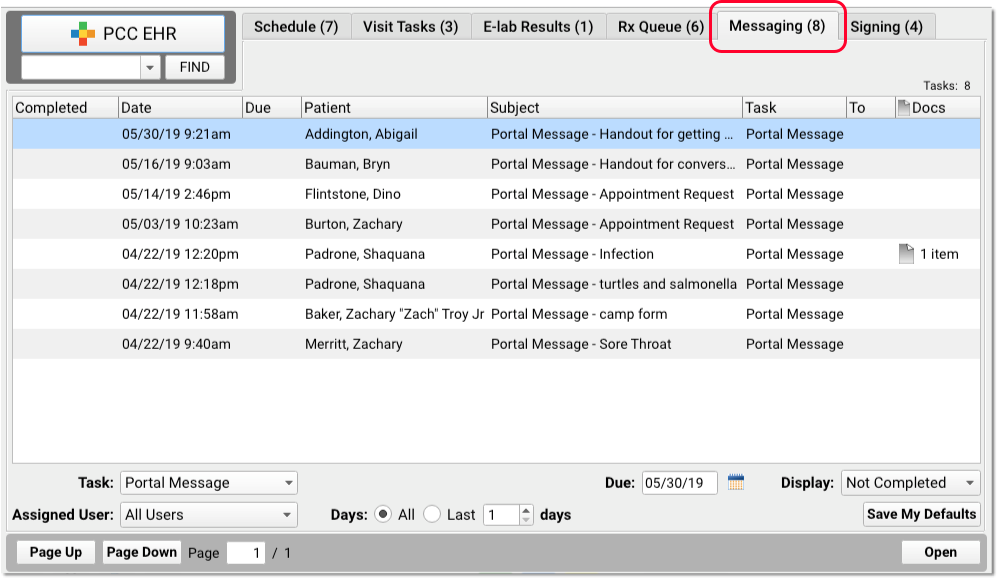
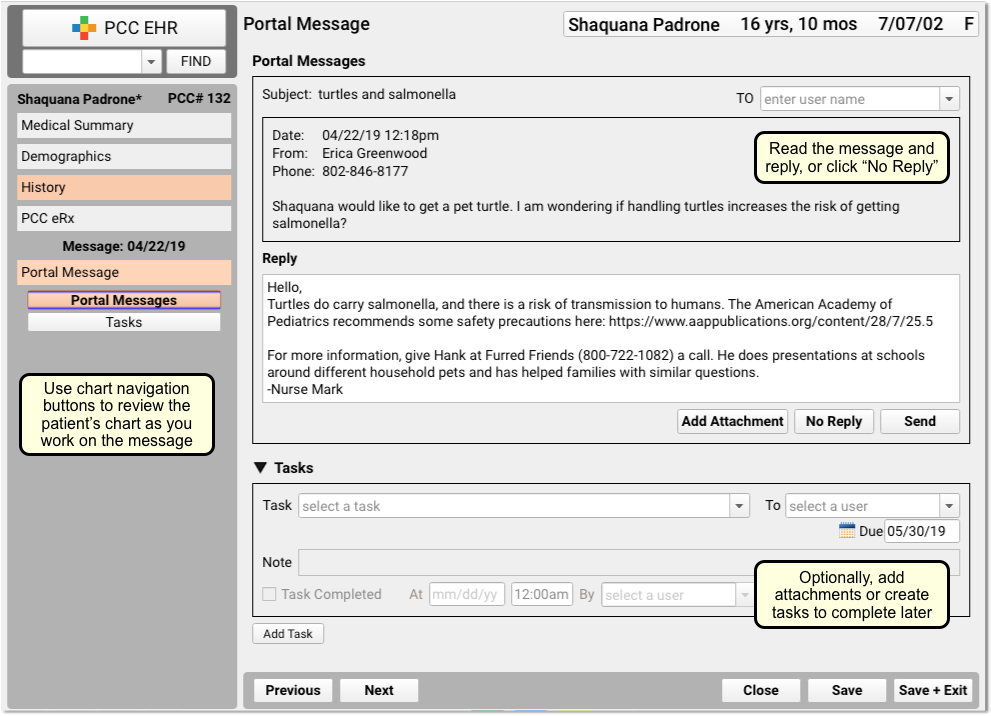
Contact PCC to set up My Kid’s Chart. Once the portal has been enabled for your office, you can turn on the Messaging feature using the Patient Portal Manager tool through PCC EHR. For help with portal configuration, read the Patient Portal Practice Settings and Configuration article on learn.pcc.com.
The EP may also send messages through PCC EHR that will show up on the patient portal. These messages will also count toward the measure, for patients who had an office visit during the EHR reporting period.

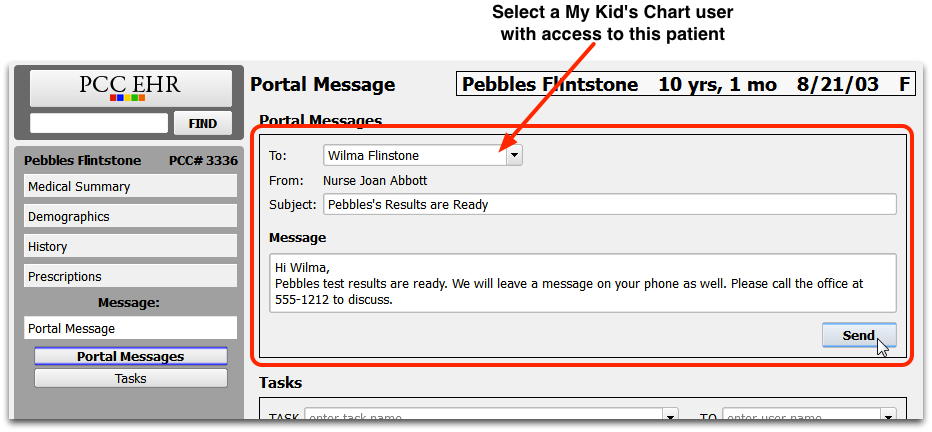
For help with portal messages, read Receive and Respond to Portal Messages from My Kid’s Chart.
Objective 10: (Y/N) Public Health Reporting
This objective requires the EP to be in active engagement with a public health agency to submit electronic public health data from a certified EHR except where prohibited and in accordance with applicable law and practice.
This is a Yes/No objective, with three separate measures.
You must be able to answer “Yes” to two out of three of the measures in order to meet this objective.
An EP must be in active engagement with a public health agency to be able to answer “Yes”.
Active engagement may include any of the following options.
- Option 1: Completed Registration [with Public Health Agency or Clinical Data Registry] to Submit Data
- Option 2: Testing and Validation: The EPis in the process of testing and validation of the electronic submission of data
- Option 3: Production: The EP has completed testing and validation of the electronic submission and is electronically submitting production data to the PHA or CDR
Measure 1: Immunization Registry Reporting
In order to meet this measure, the EP must be in active engagement with a public health agency to submit immunization data.
PCC EHR currently submits immunization data to many state registries.
Contact PCC support to determine if you are submitting to your state or if a connection can be established.
- Exclusion: Any EP that meets one or more of the following criteria may be excluded from this measure:
- Does not administer any of the immunizations to any of the populations for which data is collected by their jurisdiction’s immunization registry or immunization information system during the EHR reporting period
- Operates in a jurisdiction for which no immunization registry or immunization information system is capable of accepting the specific standards required for CEHRT at the start of their EHR reporting period
- Operates in a jurisdiction where no immunization registry or immunization information system has declared readiness to receive immunization data from the EP at the start of the EHR reporting period
Measure 2: Syndromic Surveillance Reporting
In order to meet this measure, the EP must be in active engagement with a public health agency to submit syndromic surveillance data.
- Exclusion: Any EP that meets one or more of the following criteria may be excluded from this measure:
- Is not in a category of providers from which ambulatory syndromic surveillance data is collected by their jurisdiction’s syndromic surveillance system
- Operates in a jurisdiction for which no public health agency is capable of receiving electronic syndromic surveillance data from EPs in the specific standards required to meet the CEHRT definition at the start of the EHR reporting period
- Operates in a jurisdiction where no public health agency has declared readiness to receive syndromic surveillance data from EPs at the start of the EHR reporting period
Measure 3: Specialized Registry Reporting
In order to meet this measure, the EP must be in active engagement to submit data to a specialized registry.
Check with your state and specialty society (the AAP) to determine if a specialized registry exists that will accept pediatric-specific data. This action should be documented.
- Exclusion: Any EP that meets one or more of the following criteria may be excluded from this measure:
- Does not diagnose or treat any disease or condition associated with, or collect relevant data that is collected by, a specialized registry in their jurisdiction during the EHR reporting period
- Operates in a jurisdiction for which no specialized registry is capable of accepting electronic registry transactions in the specific standards required to meet the CEHRT definition at the start of the EHR reporting period
- Operates in a jurisdiction where no specialized registry for which the EP is eligible has declared readiness to receive electronic registry transactions at the beginning of the EHR reporting period
Provider Configuration for Meaningful Use Calculations
PCC uses both billing and charting data to calculate Meaningful Use Measure percentages. Each EP needs to be correctly linked to a PCC EHR user and an underlying system provider. PCC completes this step upon your initial installation. Contact PCC Support for assistance.
